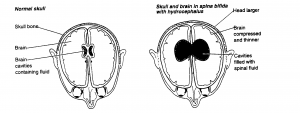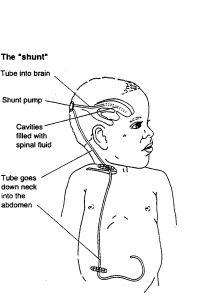The brain is surrounded by a clear, saltwater-like liquid called cerebrospinal fluid (CSF). CSF protects and nourishes the brain. It flows in a circuit through the brain cavities (ventricles) and over the surface of the brain and spinal cord. It is continuously reabsorbed by the body. Hydrocephalus occurs when there is an obstruction to the flow of CSF, causing fluid to build up within the cavities of the brain. This fluid build-up can cause pressure on the brain tissues and bones of the skull.
Most children (about 85%) with myelomeningocele will have hydrocephalus. Often the collection of fluid does not become significant until after their myelomeningocele has been surgically closed so it may not become evident until the first few days or weeks after your child’s birth.

How is Hydrocephalus Detected and Monitored?
In an infant, the bones of the skull are not yet fused together as the skull will continue to grow throughout early childhood. The bones are therefore able to shift and accommodate the excess cerebrospinal fluid and thus lessen the amount of damage to the brain. As fluid accumulates, a child’s head circumference (head size) increases. Hydrocephalus is detected and monitored through regular measurement of your child’s head circumference. Other symptoms such as sleepiness, poor feeding, vomiting, or irritability may also be present. Hydrocephalus can also be detected through scanning of the head (ultrasound, CT scan and MRI).

How is Hydrocephalus Treated?
Hydrocephalus is usually treated by insertion of a shunt – this is a device that drains, using a one-way valve, excess CSF from the brain to another part of the body, usually the abdominal cavity. Draining the excess fluid relieves any symptoms of hydrocephalus that are present. Your neurosurgeon will decide if and when your child needs a shunt.
This commonly occurs following surgical closure of the myelomeningocele, but sometimes it is done before the closure and sometimes on the same day. If a shunt is required, it will always be necessary. A shunt is for life, although a child may need their shunt replaced a few times in their lifetime. Shunts generally work well but there can be problems. Shunts can become infected, blocked or, they can twist and break. The tube from the brain to the abdomen can become too short as the child grows. Surgery may be necessary to remove or replace the shunt or lengthen it as needed.
About 40% of shunts fail in the first year for a variety of reasons. If this happens, CSF will begin to accumulate again. Problems may occur suddenly or develop gradually.
Signs and symptoms will vary with age and from individual to individual. If you notice any of these signs, you may need to contact the team here or your local medical team.
- Full or bulging fontanelle (soft spot in the skull)
- Seizures
- Enlarged head size
- Headache
- Swelling or redness along the shunt tract
- Fever
- Irritability
- Vomiting
- Drowsiness
- Loss of previous abilities
- Change in appetite
- Prominent veins on scalp
It is very important for parents and health care workers to be aware of the signs of a shunt problem and to take the child to the doctor or local hospital if they are concerned.
If your child has mild hydrocephalus, they may not require a shunt. They will need to be checked regularly for signs of evolving hydrocephalus but you should also be aware of these signs as you will need to seek medical attention if you are concerned that your child’s hydrocephalus is progressing.
